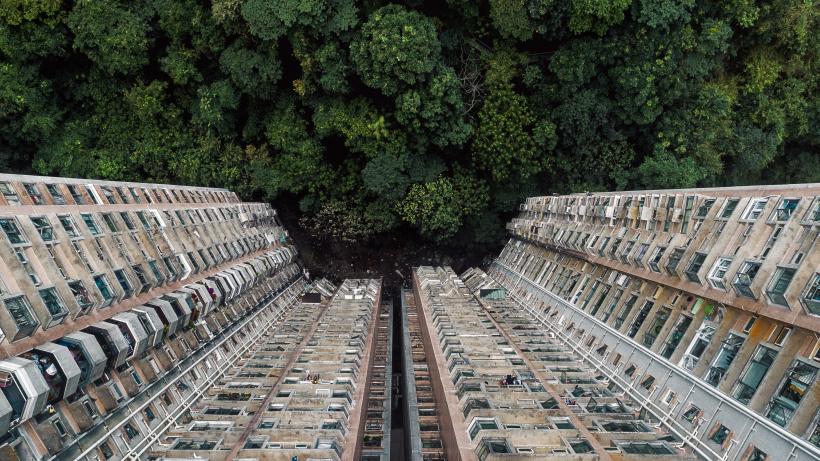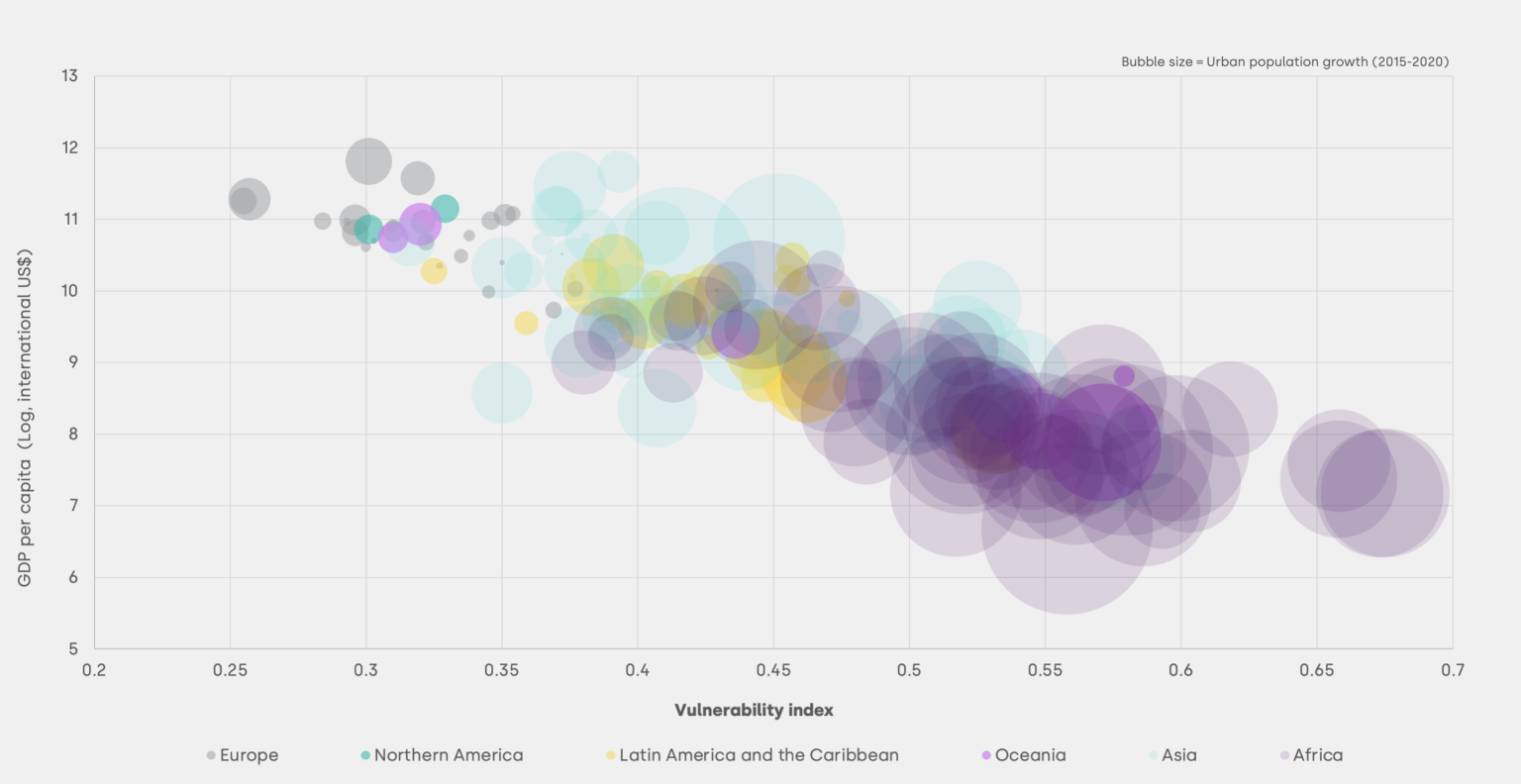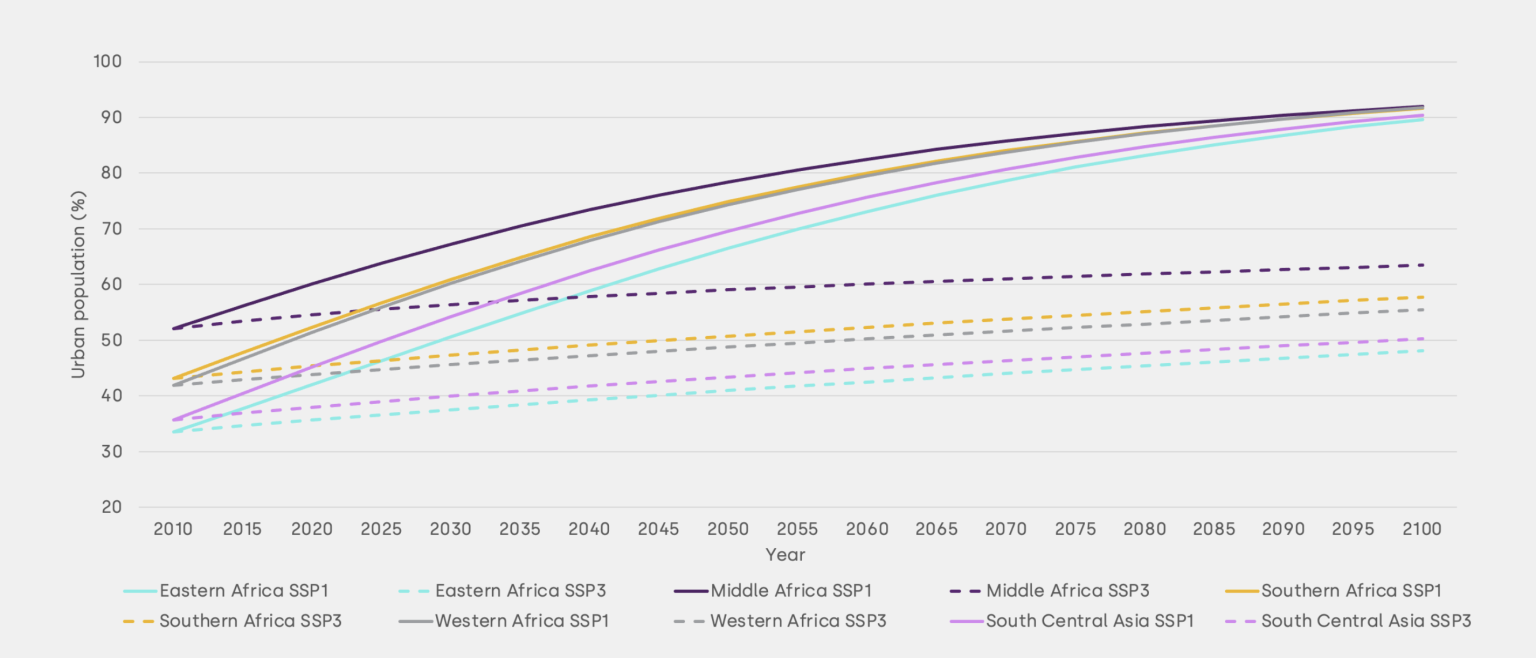
Sustainable urbanisation in developing countries: Cities as places to live
Climate change has presented cities with new challenges and opportunities for improving their liveability. If well-managed, cities offer both adaptation and mitigation benefits, as well as sustainable development opportunities, that other forms of living cannot.
-
Delbridge et al Growth brief October 2022
PDF document • 7.06 MB
Introduction
Climate change can no longer be ignored. Estimates suggest that inaction could cost the global economy between 5 and 20% of GDP each year, depending on the severity of climate change damages (Stern 2006). Resource- and carbon-efficient development, alongside adaptation mechanisms, is the only sustainable long-term option (Hickel and Kallis 2020). Sustainability is about ensuring that future generations have opportunities in terms of wellbeing that are at least as good as those available to the current generation (Stern and Valero 2021).
Getting cities right (or wrong) has long-term, locked-in consequences. This is particularly important for lower-income countries in sub-Saharan Africa and South Asia which are relatively more exposed to the effects of climate change (IPCC 2022). Developing countries that get the city-development model right have better prospects of delivering sustainable growth and improving urban resilience to climate shocks. Climate change action—with a strategic focus on resilient, well-functioning cities—can yield strong adaptation benefits, lower per capita greenhouse gas emissions (GHG) and higher growth. Focusing public policy on urban livelihoods provides economic and environmental benefits, offering cities a chance to deliver on their sustainable urbanisation potential.
Key messages
- Cities in developing countries are both the most vulnerable to climate change and the most viable solution to managing its impacts.
- Urban density enables reduction in per capita emissions from infrastructure and services.
- Access to local public goods and services aids resilience to environmental shocks and stressors.
- Decisions about the city’s physical characteristics and infrastructure today will lock-in long-term consequences for the future.
Acknowledgments: The authors would like to thank Sarah Colenbrander and Kagiso Tshukudu for their contributions to earlier versions of this work.
Key message 1 – Cities in developing countries are both the most vulnerable to climate change and the most viable solution to managing its impacts.
Climate change is a grave threat to developing countries and a major obstacle to continued poverty alleviation. Firstly, developing countries are at a geographic disadvantage—they are already warmer on average than developed countries, and they also suffer from higher rainfall variability, leading to greater weather extremes (Mirza 2003). Secondly, they are often heavily dependent on agriculture—the most climate-sensitive of all economic sectors (Thornton et al. 2014). Thirdly, their lower incomes and higher climate vulnerabilities make adaptation particularly difficult. The poorest developing countries are being hit earliest and hardest by climate change, even though they have historically contributed little to causing the problem (Friedlingstein et al. 2022).
At the same time, many developing countries are also urbanising rapidly. Cities currently hold 55% of the world’s population (IPCC 2021) and welcome 67 million new residents every year. The urban share is projected to increase to 68% by 2050 (UN DESA 2019). Crucially, 90% of the urban increases in population are expected to occur in developing countries’ cities (IPCC 2021). This is due to both high birth rates and migration, and increasingly compounded by climate-induced migration—both domestic and across borders. The interaction between climate vulnerability, regional income, and urban growth is shown in Figure 1. Here, African cities have higher urbanisation rates (represented by bigger bubbles), lower GDP per capita, and greater vulnerability to the negative impacts of climate change.
Figure 1: Climate vulnerability against GDP per capita with urbanisation rate.

Source: Based on data from World Bank for GDP per capita [Latest – 2021 or 2020]; Notre Dame Global Adaptation Initiative Country Index (ND-GAIN) for Vulnerability [Latest – 2020]; UN DESA for urban growth [2015 – 2020].
Notes: Vulnerability measures a country’s exposure, sensitivity, and ability to adapt to the negative impact of climate change. Bubble width represents urbanisation rate or urban growth.
Despite this vulnerability, cities are also the most viable solution to managing the consequences of a changing climate. Recent models by the IPCC show that sustainability and urbanisation are intrinsically linked (Riahi et al. 2017). They define five pathways for development called the Shared Socioeconomic Pathways (SSPs), based on how policymakers respond to challenges of climate change. Figure 2 shows the link between sustainability and urbanisation under two of these projections. Under SSP1—the result of stronger commitments towards adaptation and mitigation—urbanisation is much higher than under the less optimal pathway—SSP3. This is both due to emission efficiencies that compact, environmentally friendly urban areas provide, but also the opportunities they offer for adaptation (Riahi et al. 2017).
Figure 2: Urbanisation under different Shared Socioeconomic Pathways (SSPs).

Source: Based on authors’ own calculations using data from Riahi, et al. (2017)
Notes: Urbanisation is much higher in scenario SSP1, associated with greater commitment towards adaptation and mitigation.
These adaptation opportunities stem from cities’ greater efficiency in providing resilience-promoting infrastructure and services. They can also be more easily safe-guarded from extreme weather events and natural disasters (see Collier et al. 2018; Dookie and Gannon 2022). Importantly, cities are engines of productivity and rising incomes, which is one of the most important factors in overcoming the shocks and stressors associated with climate change (Oliveira-Cunha 2022).
In terms of mitigation, cities are the centre of economic activity and, therefore, can be hubs of absolute GHG emissions and air pollution.1 However, emission-generating activities tend to be more efficient in urban areas, despite higher incomes and consumption than in rural counterparts. In the majority of regions in the world, urban per capita carbon dioxide emissions are lower than national per capita emissions (IPCC 2022).2 For example, in Africa and the Middle East, national per capita emissions are estimated to be respectively 0.2 and 0.4 tonnes higher than urban. Cities can therefore lower overall emissions through resource efficiency, as well as through the deployment of cleaner technologies or practices at scale. Curbing GHG emissions has local and global benefits. At the local level, it helps in reducing the concentration of air pollutants and improving population health (Carozzi and Roth 2020).
Key message 2 – Urban density enables reduction in per capita emissions from infrastructure and services.
The viability of cities as climate solutions is in part due to the benefits of proximity—many people in one place makes the distribution of goods and services much easier and more cost-effective, with interconnected environmental benefits. While there is variation, higher population densities are correlated with lower per capita GHG emissions (Gurney et al. 2022). Within that, city centres contribute less GHG emissions per person than low-density suburbs (Jones and Kammen 2014). Estimates suggest that compact urban development can reduce emissions by almost 25% compared to current trends on urban sprawl (Creutzig et al. 2015).
Poorly managed urban sprawl locks cities into high levels of energy consumption and emissions. For example, a study of 44 cities found that those with higher density facilitated the increased use of public and non-motorised transport options. This, in turn, impacted behaviours of citizens and reduced private car ownership (Kenworthy and Newman 2015). With more shared transport, emissions and, consequently, pollution is lowered through the reduction of particle matter in the air. This has been evidenced globally, from Lagos, Nigeria (Otunola et al. 2019) to Leipzig, Germany (Bauernschuster et al. 2017). This also leads to economic benefits—for example, reducing losses to GDP from the cost of congestion, currently at 4% in Kampala (Baertsch 2020), 5% in Jakarta, 8% in São Paulo, and up to 15% in Beijing (New Climate Economy 2018).
Density also means building higher, which is good for material use and related GHG emissions. For example, mid-rise buildings in India use 30% less material per square feet of construction compared to single family homes (Nagpure et al. 2018). It also leaves more room available for green space, both within the city and at the urban edge. If well-planned, this can ensure environmentally sensitive areas are protected, and natural capital preserved. This, in turn contributes to important ecosystem services such as reducing urban heat islands, improved storm water drainage, and flood plain management (see Delbridge and Harman (2022) for further discussion). Relatedly, density enables the sharing of private and public goods and services with other citizens, including waste management, water and sanitation, and district heating.
All of these sustainability benefits are also achieved at a lower cost to government. Evidence shows that higher population density leads to more cost-effective public goods and services, with economies of scale aiding in their delivery (IPCC 2022). For example, when comparing large cities to rural areas, installation of private household water costs approximately 10% per person in cities; power (renewable and grid) approximately 20%; and roads 50%—or half per person (Foster and Briceño-Garmendia 2009).
Higher density also divides the cost of land in cities among more people, lowering the cost of safe and resilient housing (Collier et al. 2017). This, together with clearly defined and enforced land-use regulations, may aid in the reduction of unplanned settlements built on land exposed to environmental pressures, such as floods and landslides. Proactive urban planning and appropriate land-use regulation is therefore vital for a low-emission and resilient city.
Key message 3 – Access to local public goods and services aids resilience to environmental shocks and stressors.
A sustainable, liveable, and productive city is one that is resilient to environmental shocks and stressors. These acute shocks—such as heatwaves or flash floods—and chronic stressors—such as air pollution or sea-level rise—are currently impacting cities and will do so increasingly. The investments in local public goods and services that developing country cities are already grappling with, which help citizens manage these changes, will become more important. In some cases, they can also contribute to mitigation. Here, we discuss two examples, although there are many more.
Water and sanitation
Equitable access to clean drinking water and a well-functioning sanitation system is a critical component of a resilient city. Currently, accelerating climate change is worsening already limited water access, with poor, often informal communities suffering from water shortages arising from frequent droughts. Harsh storms are damaging water and sanitation facilities, and heavy rainfall or sea-level rise is causing sewage to spread across communities.
The latter has been studied in Dar es Salaam, Tanzania, showing heavy extreme rainfall leading to the spread of cholera (Picarelli et al. 2017). This impacted citizens’ health either directly—as residents encounter pathogens—or indirectly—as precautions reduce citizen’s ability to work, thus lowering their income and adaptation ability. The spread was worse in areas with poor local public goods—specifically, water, sanitation, and roads. Figure 3 shows the considerable variation in water and sanitation provision across urban areas in Africa, with only 13% provision in Liberia compared to 60% in neighbouring Cote D’Ivoire.
Figure 3: Water and sanitation provision across urban Africa.
Notes: Legend indicates percentage (or share) of sampled households that had the service present in the primary sampling unit / enumeration area. Grey indicates data unavailable. Colours indicate high variation in urban water and sanitation provision across Africa. Urban respondents only. N=19,699. Click here to access the interactive version of this map. Source: Author’s own calculations based on Afrobarometer survey data (2016-2018). Dataset showing provision of piped water system and provision of sewage system merged in urban sampling units.
Waste management
As populations rise in most developing country cities, waste generation increases at a faster rate (Kaza et al. 2018). For example, in Kigali, waste generation is increasing at four times the rate of its population growth (Rajashekar and Bowers 2019). As a result of this growth, stretched collection systems see waste either being burnt or dumped by citizens wanting to dispose of it in the least costly way. Dumped waste can block drains and contaminate aquifers. This leads to the acute shock of localised flooding common in developing country cities, like Accra (Amoako and Frimpong Boamah 2020).
Meanwhile, burnt waste emits super air pollutants like black carbon and methane. These pollutants absorb sunlight strongly, increasing local temperatures and urban heat island effect at a rate much higher than carbon dioxide (Schmale, Shindell et al. 2014). They also have global GHG consequences, with black carbon emissions contributing to over 2 to 10% of global carbon dioxide equivalent emissions, and methane at waste disposal sites contributing a further 3 to 4% (Reyna-Bensusan et al. 2019). Tackling waste management thus, contributes to both adaptation, mitigation, and local health and productivity benefits.
While there are some challenges we can predict and some decisions where the outcomes are reasonably clear, others are clouded by uncertainty. For example, flash flood-prone areas are fairly well-known, and we can begin to address this now (UNESCO 2022). Other challenges are more uncertain, such as how vulnerable certain neighbourhoods will be to sea-level rise. The risk to cities will depend on the world’s commitments and ability to manage global warming, but also interacts with how they themselves will change—thus requiring longer term adaptation planning for the future (Collier et al. 2018). Despite different levels of uncertainty, many of these decisions must be made today to avoid locking into unfavourable outcomes in the future.
Key message 4 – Decisions about the city’s physical characteristics and infrastructure today will lock-in long-term consequences for the future.
The typical lifespan of urban infrastructure and building stock is estimated at approximately 125 and 75 years respectively (IEA 2020). As cities grow rapidly, choices on transport, infrastructure, buildings, and industry will determine the technology, institutions and behaviours they lock in—with direct implications on future emissions. For example, in non-OECD countries, infrastructure related to power, industry, transport and buildings which was built or under construction in 2011 has locked in—or permanently committed to—360 gigatonnes of carbon emissions until 2035 (IEA 2013).
While growth and adaptation remain the priority for rapidly urbanising developing economies, they also have an important choice to make on whether to adopt high or low resource-intensive development paths. The former may appear cheaper in the short-run and require less careful planning. But recent evidence shows that, compared to continued fossil fuel use, a rapid green energy transition will result in trillions of net savings in the long-term (Way et al. 2022). Furthermore, if less efficient technologies are chosen now, longer-term investments in built environment, energy and connectivity will more than triple in order to reverse the carbon output (IEA 2013).
The chosen energy mix, which is the biggest contributor to global GHG emissions, is a major factor that will impact what complementary ‘green’ technologies can be employed across the economy (Stern and Valero 2021). It will affect whether electric vehicles become a viable option in a particular city, protecting against future volatility in fossil fuel prices and reducing local air pollution. It will also determine the viability of green industry and trade that the city can build comparative advantages in (see companion piece Delbridge et al. 2022). Another example is immobile physical capital—commercial and residential buildings. As cities are rapidly growing, the built environment needs to be constructed. Sustainable building construction employed now can reduce current and future emissions, while also helping cities to adapt to the effects of climate change.
While currently African cities are relatively low carbon emitters in absolute terms, their economies are relatively more carbon intensive (see Figure 4 below). In fact, carbon intensity in Africa–measured in kg of carbon dioxide per international US$ of GDP of output—is higher than in Europe. Asian economies are more carbon intensive still. Assessing what bottlenecks and incentive structures are inhibiting a green transition and acting for their removal will help in avoiding lock-in to this more costly development pathway in the long term. In particular, identifying appropriate financing mechanisms – that are accessible and easy to navigate, focus on local priorities, and account for climate justice considerations—is vital. This will help developing cities to weather possible higher upfront investment costs.
Figure 4: Carbon intensity of economies.
Notes: Carbon dioxide (CO2) intensity of economies measured in kilograms of CO2 per international US$ of GDP, 2011 prices. For ease of comparison, continental data on CO2 intensity is: Europe – 0.23; Africa – 0.24; Asia – 0.38; North America – 0.29; South America – 0.18; Oceania – 0.33. Click here and here to access the interactive versions of these maps. Source: Author’s own calculations based on Global Carbon Project and Maddison Project Database 2020 (Bolt and van Zanden 2020).
Policy recommendations
Sustainable urbanisation is vital for cities in developing countries to adapt to and mitigate climate change without sacrificing urgent needs for socioeconomic development. Long-term planning horizons, prioritising large-scale investment in critical urban infrastructure and services, and ensuring local regulation is fit for purpose, will all be key in realising this transition. Perhaps most important is ensuring that sustainable urbanisation in developing countries is not left to cities alone, but rather prioritised by national governments, as well as global development partners. Doing so ahead of the impending urban population growth is the only affordable option—avoiding costly retrofitting in the future once settlement has already occurred.
1. Invest in sustainable urbanisation for adapting to and mitigating climate change.
Developing country cities can be vehicles not just for driving economic growth and delivering public goods, but also for supporting climate resilience and emissions reduction at scale. If managed well their density and economies of scale have the potential to provide citizens with the incomes desired without substantial loss to the environment. Thus, global organisations, national governments, and local bodies should place greater emphasis on urgently investing in the urban infrastructure and institutions that will ensure development occurs in a sustainable, liveable, and productive way.
2. Coordinate land use and building regulations to facilitate density and appropriate zoning.
Sustainable urbanisation requires coordinated land use planning to facilitate compact and connected urban form. Unplanned and sprawling cities have many negative environmental consequences. To achieve this density, policymakers should ensure that building regulations, such as minimum plot sizes, floor area ratios, and construction standards are appropriate for the context. Purposeful zoning and its enforcement, particularly around environmentally sensitive areas, are also important considerations to avoid climate-related risks—see Collier et al. (2020).
3. Concentrate on the provision of basic urban infrastructure and services—they can help cushion against climate shocks.
Core urban investments—including water and sanitation, waste management, roads, and transport infrastructure—that are needed to build liveable and productive cities, can also support building more sustainable and climate resilient cities. These local public goods and services both cushion against shocks and facilitate recovery, therefore aiding adaptation. There is scope for integrating more sustainable technologies and behaviours, as well as ecosystem services which can passively work alongside active interventions to achieve this.
4. Ensure decisions made on development and adaptation today will not commit to costly emissions and retrofitting in the future.
Decisions on the energy mix, transport and the built environment have costly, long-lasting impacts and are often difficult to reverse. In facing these challenges, it is useful to consider how today’s decisions will potentially affect both adaptation and emissions trajectories in years to come, and the associated long-term costs. In poor developing country cities, policies should aim at raising incomes and local adaptation to acute shocks, but they should also consider future costs of high emissions and associated constraints on growth. This includes supporting longer-term mitigation efforts to reduce chronic local stressors, such as air pollution and health, and benefit from growing green industry and trade (see companion piece (Delbridge et al. 2022).
5. Engage all levels of government in designing and delivering a sustainable urbanisation approach.
Delivering this will not be easy, partly because the necessary governance of climate action is complex and not just a simple urban matter that can be left to local authorities. The impacts of climate change are rarely confined within municipal boundaries. When considering the key messages, it is important to engage all levels of government, as well as the private sector and civil society. Each institution and actor should have a clear mandate within the city’s overarching strategy to drive sustainable urbanisation.
Notes
1 Cities’ emissions vary depending on land use, energy consumption and a variety of socioeconomic and geographical factors WEF (2022) “Delivering Climate Resilient Cities Using A Systems Approach.” Insight Report.
2 Except Asia.
References
Amoako, C., and Frimpong Boamah, E. (2020). Becoming vulnerable to flooding: An urban assemblage view of flooding in an African city, Planning Theory & Practice, 21(3), 371-391.
Baertsch, L. (2020). Quantifying the economic benefits of public transportation in Kampala, International Growth Centre Policy Brief.
Bauernschuster, S., Hener, T. and Rainer , H. (2017). When labor disputes bring cities to a standstill: The impact of public transit strikes on traffic, accidents, air pollution, and health, American Economic Journal: Economic Policy, 9(1), 1-37.
Bolt, J. and van Zanden, J. (2020). Maddison style estimates of the evolution of the world economy, A new 2020 update, Maddison Project Database.
Carozzi, F. and Roth, S. (2020). Dirty density: Air quality and the density of American cities, IZA Discussion Paper.
Collier, P., Glaeser, E., Venables, A. and Harman, O. (2018). Embedding resilience: city responses to acute shocks and chronic stresses, Global Future Cities Policy Framing Paper.
Collier, P., Glaeser, E., Venables, A. and Manwaring, P. (2020). Urban land use planning for economic growth. IGC Cities that Work Policy Framing Paper.
Collier, P., Glaeser, E., Venables, A., Manwaring, P. and Blake, M. (2017). Land and property taxes for municipal finance, International Growth Center, London School of Economic and Political Science: London, UK.
Creutzig, F., Baiocchi, G., Bierkandt, R., Pichler, P.-P. and Seto, K.C. (2015). Global typology of urban energy use and potentials for an urbanisation mitigation wedge, Proceedings of the National Academy of Sciences, 112(20), 6283-6288.
Delbridge, V. and Harman, O. (2022). Sale of ecosystem services in cities, IGC Blog.
Delbridge, V., Harman, O., Oliveira-Cunha, J. and Venables, A. (2022). Sustainable urbanisation in developing countries: Cities as places to innovate, trade and work, IGC Growth Brief.
Dookie, D. and Gannon, K. (2022). Why is climate change adaptation important for cities and how are they adapting?. https://www.lse.ac.uk/granthaminstitute/explainers/why-is-climate-change-adaptation-important-for-cities-and-how-are-they-adapting/
Foster, V. and Briceño-Garmendia, C.M. (2009). Africa’s infrastructure: a time for transformation, The World Bank.
Friedlingstein, P., Jones, M.W., O’Sullivan, M., Andrew, R.M., Bakker, D. C. E., Hauck, J., Le Quéré, C., Peters, G. P. , Peters, W., Pongratz, J., Sitch, S., Canadell, J. G., Ciais, P., Jackson, R. B., Alin, S. R., Anthoni, P., Bates, N. R., Becker, M., Bellouin, N., Bopp, L., Chau, T. T. T. , Chevallier, F., Chini, L. P., Cronin, M., Currie, K. I., Decharme, B., Djeutchouang, L.M., Dou, X., Evans, W., Feely, R. A., Feng, L., Gasser,T., Gilfillan, D., Gkritzalis, T., Grassi, G., Gregor,L., Gruber,N., Gürses, Ö., Harris, I., Houghton, R. A., Hurtt, G. C., Iida, Y., Ilyina, T., Luijkx, I. T., Jain, A., Jones, S. D., Kato, E., Kennedy, D., Klein Goldewijk, K., Knauer, J., Korsbakken, J. I., Körtzinger, A., Landschützer, P., Lauvset, S. K., Lefèvre, N., Lienert, S., Liu, J., Marland, G., McGuire, P. C., Melton, J. R., Munro, D. R., Nabel, J. E. M. S., Nakaoka, S. I., Niwa, Y., Ono, T., Pierrot, D., Poulter, B., Rehder, G., Resplandy, L., Robertson, E., Rödenbeck, C., Rosan, T. M., Schwinger, J., Schwingshackl, C., Séférian, R., Sutton, A. J., Sweeney, C., Tanhua, T., Tans, P. P., Tian, H., Tilbrook, B., Tubiello, F., van der Werf, G. R., Vuichard, N., Wada, C., Wanninkhof, R., Watson, A. J., Willis, D., Wiltshire, A. J., Yuan, W., Yue, C., Yue, X., Zaehle, S. and Zeng, J. (2022). Global Carbon Budget 2021, Earth Syst. Sci. Data, 14(4), 1917-2005.
Gurney, K. R., Kılkış, Ş., Seto, K. C., Lwasa, S., Moran, D., Riahi, K., Keller, M., Rayner, P. and Luqman, M. (2022). Greenhouse gas emissions from global cities under SSP/RCP scenarios, 1990 to 2100, Global Environmental Change, 73, 102478.
Hickel, J. and Kallis, G. (2020). Is green growth possible?, New political economy, 25(4), 469-486.
IEA (2013). Redrawing the energy climate map, Paris, International Energy Agency.
IEA (2020). Energy technology Perspectives 2020, IEA, DOI: https://iea.blob.core.windows.net/assets/7f8aed40-89af-4348-be19-c8a67df0b9ea/Energy_Technology_Perspectives_2020_PDF.pdf.
IPCC (2021). Climate change 2021: The physical science basis, Contribution of working group I to the sixth assessment report of the intergovernmental panel on climate change.
IPCC (2022). Climate change 2022: Mitigation of climate change, Contribution of working group III to the Sixth Assessment Report of the Intergovernmental Panel on Climate Change.
Jones, C. and Kammen, D. M. (2014). Spatial distribution of U.S. household Carbon footprints reveals suburbanization undermines greenhouse gas benefits of urban population density, Environmental Science & Technology, 48(2), 895-902.
Kaza, S., Yao, L. , Bhada-Tata, P. and Van Woerden, F. (2018). What a waste 2.0: a global snapshot of solid waste management to 2050, The World Bank.
Kenworthy, J. and Newman, P. (2015). The end of automobile dependence: How cities are moving beyond car-based planning, Island Press.
Mirza, M. M. Q. (2003). Climate change and extreme weather events: can developing countries adapt?, Climate Policy, 3(3), 233-248.
Nagpure, A. S., Reiner, M. and Ramaswami, A. (2018). Resource requirements of inclusive urban development in India: insights from ten cities, Environmental Research Letters, 13(2), 025010.
New Climate Economy (2018). Unlocking the inclusive growth story of the 21st century: Accelerating climate action in urgent times: 18.
Oliveira-Cunha, J. (2022). Three ways in which cities can spur development and climate change adaptation, IGC Blog.
Otunola, B., Kriticos, S. and Harman, O. (2019). The BRT and the danfo: a case study of Lagos’ transport reforms from 1999-2019.
Picarelli, N., Jaupart, P. and Chen, Y. (2017). Cholera in times of floods, IGC Working Paper.
Rajashekar, A. and Bowers, A. (2019). Assessing waste management services in Kigali, International Growth Centre, Policy Brief.
Reyna-Bensusan, N., Wilson, D. C., Davy, P. M., Fuller, G. W., Fowler, G. D. and Smith, S. R. (2019). Experimental measurements of black carbon emission factors to estimate the global impact of uncontrolled burning of waste, Atmospheric Environment, 213, 629-639.
Riahi, K., van Vuuren, D. P., Kriegler, E., Edmonds, J., O’Neill, B. C., Fujimori, S., Bauer, N., Calvin, K., Dellink, R., Fricko, O., Lutz, W., Popp, A., Cuaresma, J. C., Kc, S., Leimbach, M., Jiang, L., Kram, T., Rao, S., Emmerling, J., Ebi, K., Hasegawa, T., Havlik, P., Humpenöder, F., Da Silva, L. A., Smith, S., Stehfest, E., Bosetti, V., Eom, J., Gernaat, D., Masui, T., Rogelj, J., Strefler, J., Drouet, L., Krey, V., Luderer, G., Harmsen, M., Takahashi, K., Baumstark, L. , Doelman, J. C., Kainuma, M., Klimont, Z., Marangoni, G., Lotze-Campen, H. , Obersteiner, M., Tabeau, A. and Tavoni, M. (2017). The shared socioeconomic pathways and their energy, land use, and greenhouse gas emissions implications: An overview, Global Environmental Change, 42, 153-168.
Schmale, J., Shindell, D., von Schneidemesser, E., Chabay, I. and Lawrence, M. (2014). Air pollution: Clean up our skies, Nature, 515(7527), 335-337.
Stern, N. (2006). Stern Review: The economics of climate change.
Stern, N. and Valero, A. (2021). Innovation, growth and the transition to net-zero emissions, Research Policy, 50(9), 104293.
Thornton, P. K., Ericksen, P. J., Herrero, M. and Challinor, A. J. (2014). Climate variability and vulnerability to climate change: a review, Global Change Biology, 20(11), 3313-3328.
UN DESA (2019). World Urbanization Prospects.
UNESCO (2022). Being able to predict floods will save lives in West Africa.
Way, R., Ives, M. C., Mealy, P. and Farmer, J. D. (2022). Empirically grounded technology forecasts and the energy transition, Joule.
WEF (2022). Delivering climate resilient cities using a systems approach, Insight Report.
Citation
Delbridge, V., Harman, O., Oliveira-Cunha, J., & Venables, A., (2022). Sustainable urbanisation in developing countries: Cities as places to live. International Growth Centre Growth Brief Series 026.





